Impact of GDP, Labor Market, Inflation, and Interest Rates on McDonald’s in UK and China
VerifiedAdded on 2023/06/03
|13
|3448
|335
AI Summary
This article discusses the impact of GDP, labor market, inflation, and interest rates on McDonald’s in the UK and China. It covers topics such as government spending, trade, and exchange rates. The article also highlights the growth of McDonald’s and its expansion into global markets.
Contribute Materials
Your contribution can guide someone’s learning journey. Share your
documents today.

Running head: McDonald’s 1
McDonald’s
Student’s name
Institution Affiliation
Date
McDonald’s
Student’s name
Institution Affiliation
Date
Secure Best Marks with AI Grader
Need help grading? Try our AI Grader for instant feedback on your assignments.
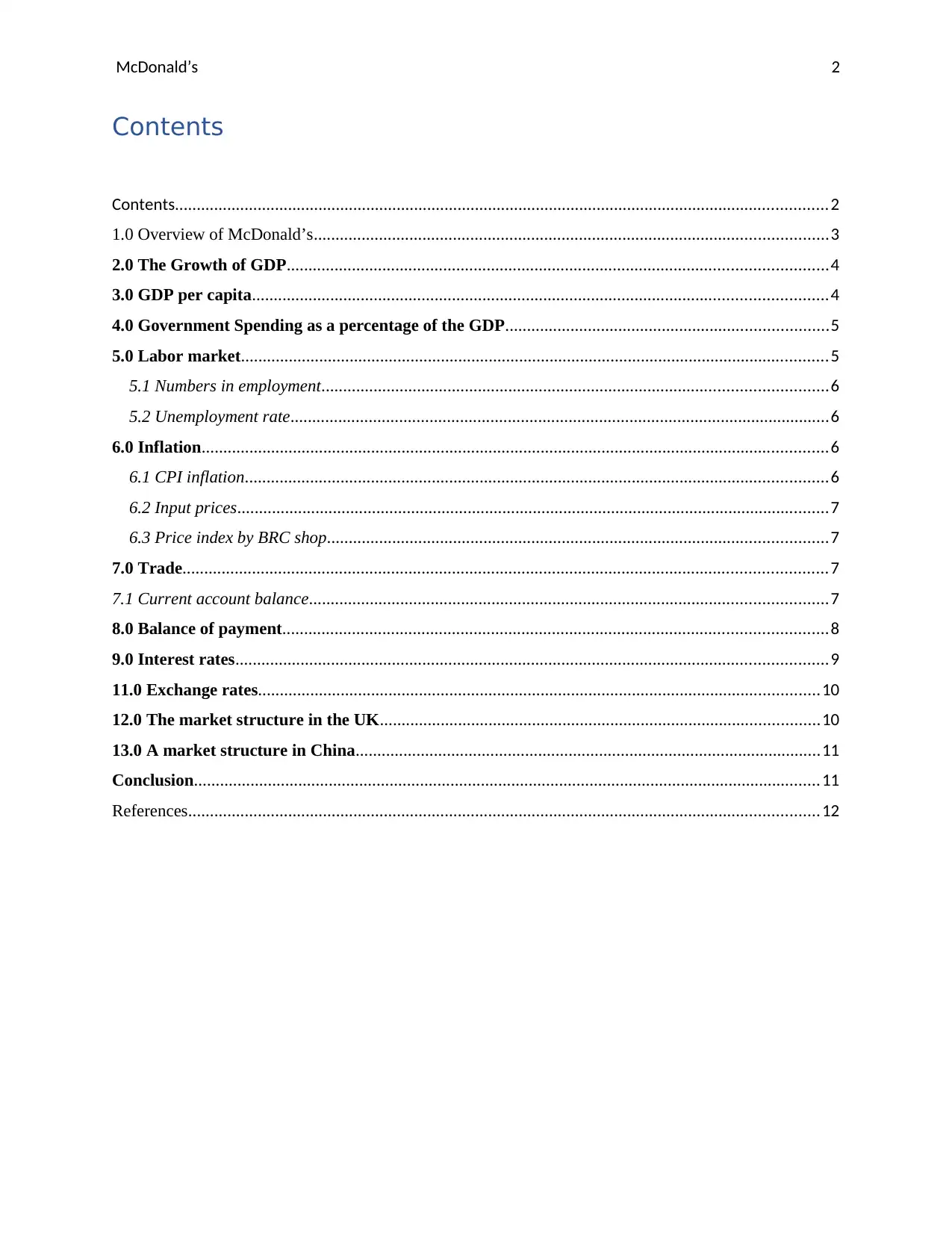
McDonald’s 2
Contents
Contents......................................................................................................................................................2
1.0 Overview of McDonald’s......................................................................................................................3
2.0 The Growth of GDP............................................................................................................................4
3.0 GDP per capita....................................................................................................................................4
4.0 Government Spending as a percentage of the GDP..........................................................................5
5.0 Labor market.......................................................................................................................................5
5.1 Numbers in employment....................................................................................................................6
5.2 Unemployment rate............................................................................................................................6
6.0 Inflation................................................................................................................................................6
6.1 CPI inflation......................................................................................................................................6
6.2 Input prices........................................................................................................................................7
6.3 Price index by BRC shop...................................................................................................................7
7.0 Trade....................................................................................................................................................7
7.1 Current account balance.......................................................................................................................7
8.0 Balance of payment.............................................................................................................................8
9.0 Interest rates........................................................................................................................................9
11.0 Exchange rates.................................................................................................................................10
12.0 The market structure in the UK.....................................................................................................10
13.0 A market structure in China...........................................................................................................11
Conclusion................................................................................................................................................11
References.................................................................................................................................................12
Contents
Contents......................................................................................................................................................2
1.0 Overview of McDonald’s......................................................................................................................3
2.0 The Growth of GDP............................................................................................................................4
3.0 GDP per capita....................................................................................................................................4
4.0 Government Spending as a percentage of the GDP..........................................................................5
5.0 Labor market.......................................................................................................................................5
5.1 Numbers in employment....................................................................................................................6
5.2 Unemployment rate............................................................................................................................6
6.0 Inflation................................................................................................................................................6
6.1 CPI inflation......................................................................................................................................6
6.2 Input prices........................................................................................................................................7
6.3 Price index by BRC shop...................................................................................................................7
7.0 Trade....................................................................................................................................................7
7.1 Current account balance.......................................................................................................................7
8.0 Balance of payment.............................................................................................................................8
9.0 Interest rates........................................................................................................................................9
11.0 Exchange rates.................................................................................................................................10
12.0 The market structure in the UK.....................................................................................................10
13.0 A market structure in China...........................................................................................................11
Conclusion................................................................................................................................................11
References.................................................................................................................................................12
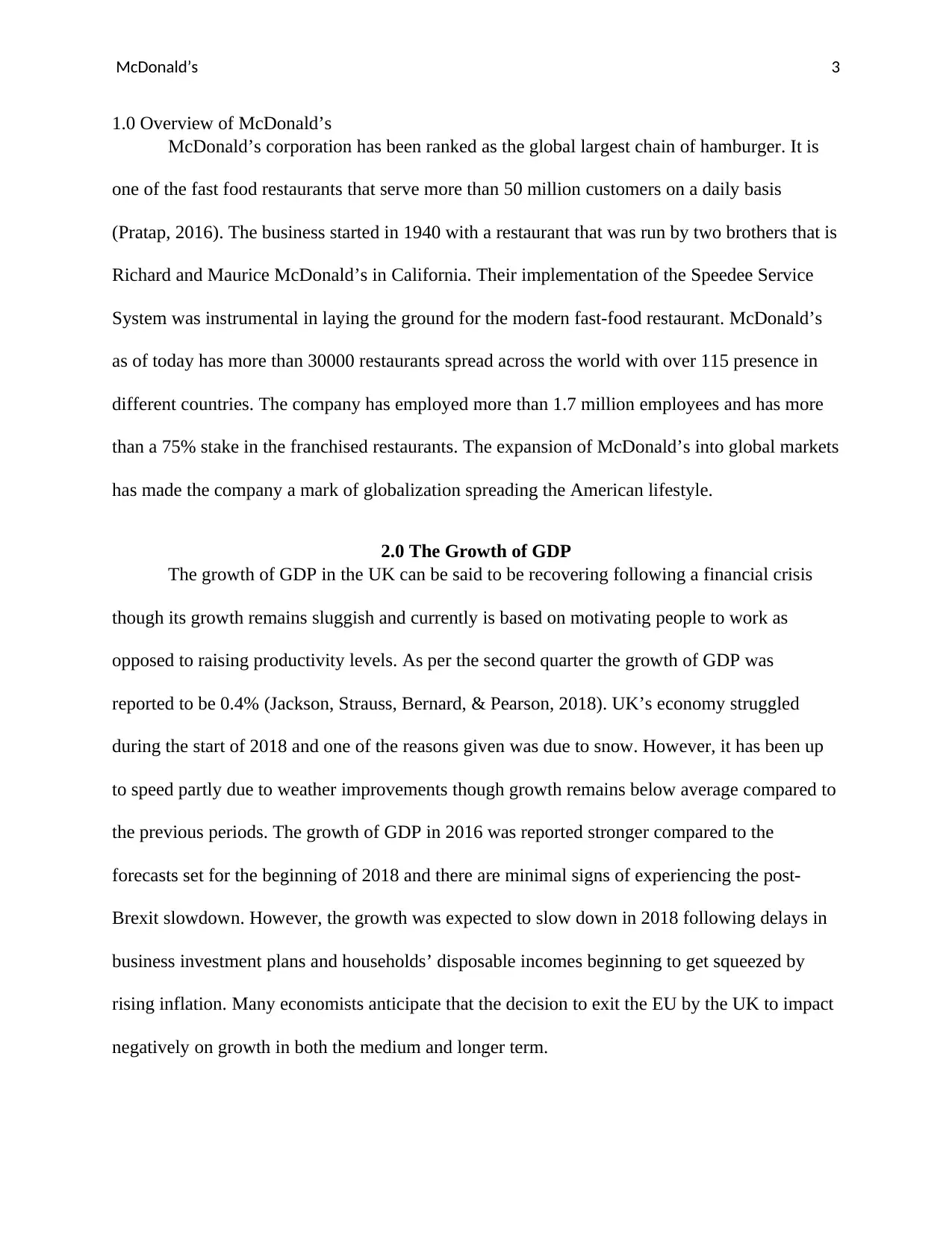
McDonald’s 3
1.0 Overview of McDonald’s
McDonald’s corporation has been ranked as the global largest chain of hamburger. It is
one of the fast food restaurants that serve more than 50 million customers on a daily basis
(Pratap, 2016). The business started in 1940 with a restaurant that was run by two brothers that is
Richard and Maurice McDonald’s in California. Their implementation of the Speedee Service
System was instrumental in laying the ground for the modern fast-food restaurant. McDonald’s
as of today has more than 30000 restaurants spread across the world with over 115 presence in
different countries. The company has employed more than 1.7 million employees and has more
than a 75% stake in the franchised restaurants. The expansion of McDonald’s into global markets
has made the company a mark of globalization spreading the American lifestyle.
2.0 The Growth of GDP
The growth of GDP in the UK can be said to be recovering following a financial crisis
though its growth remains sluggish and currently is based on motivating people to work as
opposed to raising productivity levels. As per the second quarter the growth of GDP was
reported to be 0.4% (Jackson, Strauss, Bernard, & Pearson, 2018). UK’s economy struggled
during the start of 2018 and one of the reasons given was due to snow. However, it has been up
to speed partly due to weather improvements though growth remains below average compared to
the previous periods. The growth of GDP in 2016 was reported stronger compared to the
forecasts set for the beginning of 2018 and there are minimal signs of experiencing the post-
Brexit slowdown. However, the growth was expected to slow down in 2018 following delays in
business investment plans and households’ disposable incomes beginning to get squeezed by
rising inflation. Many economists anticipate that the decision to exit the EU by the UK to impact
negatively on growth in both the medium and longer term.
1.0 Overview of McDonald’s
McDonald’s corporation has been ranked as the global largest chain of hamburger. It is
one of the fast food restaurants that serve more than 50 million customers on a daily basis
(Pratap, 2016). The business started in 1940 with a restaurant that was run by two brothers that is
Richard and Maurice McDonald’s in California. Their implementation of the Speedee Service
System was instrumental in laying the ground for the modern fast-food restaurant. McDonald’s
as of today has more than 30000 restaurants spread across the world with over 115 presence in
different countries. The company has employed more than 1.7 million employees and has more
than a 75% stake in the franchised restaurants. The expansion of McDonald’s into global markets
has made the company a mark of globalization spreading the American lifestyle.
2.0 The Growth of GDP
The growth of GDP in the UK can be said to be recovering following a financial crisis
though its growth remains sluggish and currently is based on motivating people to work as
opposed to raising productivity levels. As per the second quarter the growth of GDP was
reported to be 0.4% (Jackson, Strauss, Bernard, & Pearson, 2018). UK’s economy struggled
during the start of 2018 and one of the reasons given was due to snow. However, it has been up
to speed partly due to weather improvements though growth remains below average compared to
the previous periods. The growth of GDP in 2016 was reported stronger compared to the
forecasts set for the beginning of 2018 and there are minimal signs of experiencing the post-
Brexit slowdown. However, the growth was expected to slow down in 2018 following delays in
business investment plans and households’ disposable incomes beginning to get squeezed by
rising inflation. Many economists anticipate that the decision to exit the EU by the UK to impact
negatively on growth in both the medium and longer term.
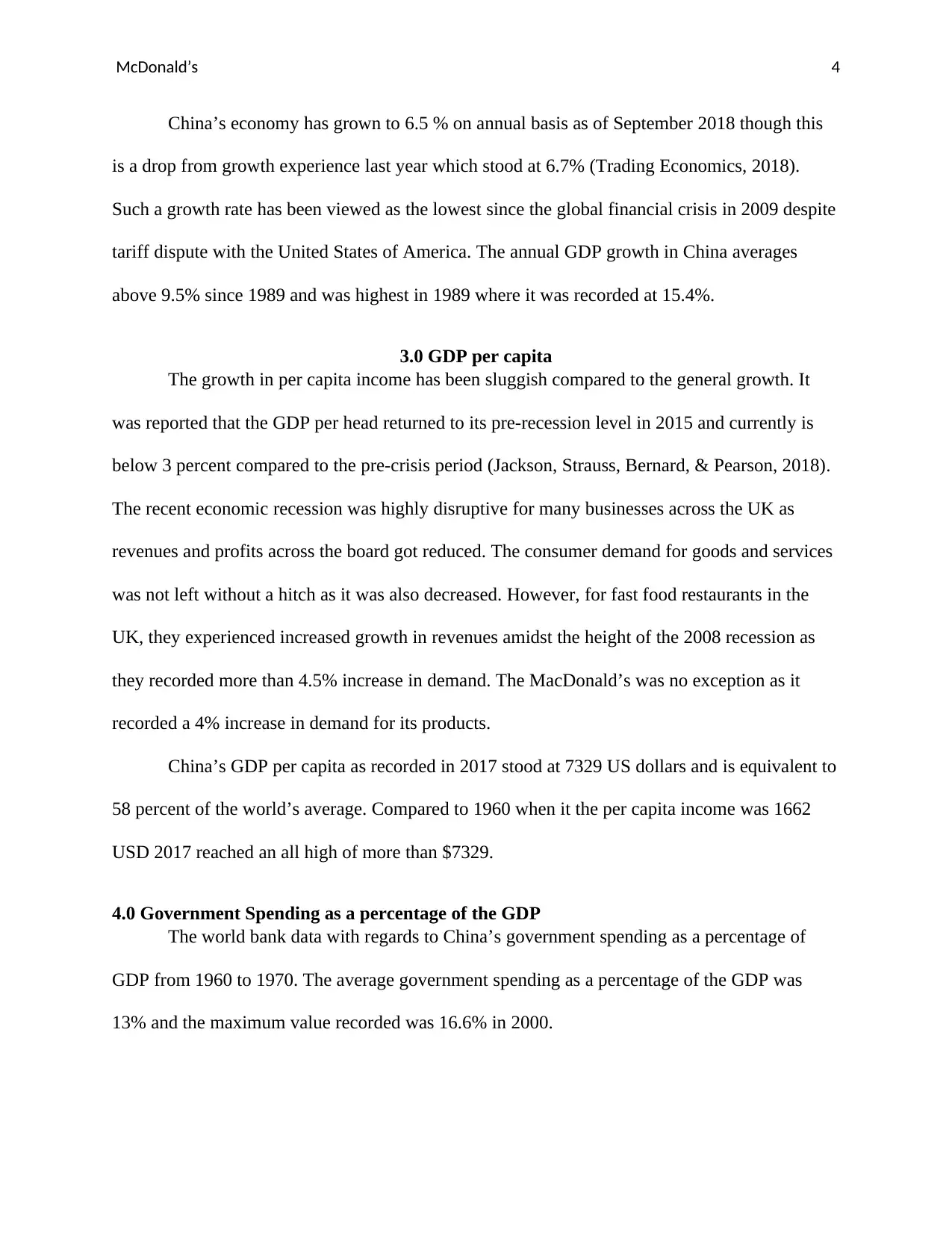
McDonald’s 4
China’s economy has grown to 6.5 % on annual basis as of September 2018 though this
is a drop from growth experience last year which stood at 6.7% (Trading Economics, 2018).
Such a growth rate has been viewed as the lowest since the global financial crisis in 2009 despite
tariff dispute with the United States of America. The annual GDP growth in China averages
above 9.5% since 1989 and was highest in 1989 where it was recorded at 15.4%.
3.0 GDP per capita
The growth in per capita income has been sluggish compared to the general growth. It
was reported that the GDP per head returned to its pre-recession level in 2015 and currently is
below 3 percent compared to the pre-crisis period (Jackson, Strauss, Bernard, & Pearson, 2018).
The recent economic recession was highly disruptive for many businesses across the UK as
revenues and profits across the board got reduced. The consumer demand for goods and services
was not left without a hitch as it was also decreased. However, for fast food restaurants in the
UK, they experienced increased growth in revenues amidst the height of the 2008 recession as
they recorded more than 4.5% increase in demand. The MacDonald’s was no exception as it
recorded a 4% increase in demand for its products.
China’s GDP per capita as recorded in 2017 stood at 7329 US dollars and is equivalent to
58 percent of the world’s average. Compared to 1960 when it the per capita income was 1662
USD 2017 reached an all high of more than $7329.
4.0 Government Spending as a percentage of the GDP
The world bank data with regards to China’s government spending as a percentage of
GDP from 1960 to 1970. The average government spending as a percentage of the GDP was
13% and the maximum value recorded was 16.6% in 2000.
China’s economy has grown to 6.5 % on annual basis as of September 2018 though this
is a drop from growth experience last year which stood at 6.7% (Trading Economics, 2018).
Such a growth rate has been viewed as the lowest since the global financial crisis in 2009 despite
tariff dispute with the United States of America. The annual GDP growth in China averages
above 9.5% since 1989 and was highest in 1989 where it was recorded at 15.4%.
3.0 GDP per capita
The growth in per capita income has been sluggish compared to the general growth. It
was reported that the GDP per head returned to its pre-recession level in 2015 and currently is
below 3 percent compared to the pre-crisis period (Jackson, Strauss, Bernard, & Pearson, 2018).
The recent economic recession was highly disruptive for many businesses across the UK as
revenues and profits across the board got reduced. The consumer demand for goods and services
was not left without a hitch as it was also decreased. However, for fast food restaurants in the
UK, they experienced increased growth in revenues amidst the height of the 2008 recession as
they recorded more than 4.5% increase in demand. The MacDonald’s was no exception as it
recorded a 4% increase in demand for its products.
China’s GDP per capita as recorded in 2017 stood at 7329 US dollars and is equivalent to
58 percent of the world’s average. Compared to 1960 when it the per capita income was 1662
USD 2017 reached an all high of more than $7329.
4.0 Government Spending as a percentage of the GDP
The world bank data with regards to China’s government spending as a percentage of
GDP from 1960 to 1970. The average government spending as a percentage of the GDP was
13% and the maximum value recorded was 16.6% in 2000.
Secure Best Marks with AI Grader
Need help grading? Try our AI Grader for instant feedback on your assignments.

McDonald’s 5
Government spending as a percentage of GDP in the UK stood at 41% as of 2017.
Government spending with regards to GDP averages 43% as from 1973 to 2017 and reached all
high in 1981 when it was 51%.
5.0 Labor market
The low unemployment rate in the UK that has been archived historical has been one of
the primary economic success narratives of last year (Jackson, Strauss, Bernard, & Pearson,
2018). The market was characterized by part-timers and then self-employed, employment growth
has widened to encompass full-time employees. However, real wages that had begun to recover
after the financial crisis started dropping again this year due to the depreciation of the sterling
pound following the Brexit vote. This has also spread through affecting consumer prices though
nominal wage remains relatively stable as it has not risen. The unemployment rate stands at 4%
with the employment rate being more than 75%.
5.1 Numbers in employment
The UK records a high number of people in work despite some projections that the rate of
unemployment may rise due to the Brexit vote. The recent growth witnessed in employment
levels can be attributed to full-time workers and employees as opposed to the part-time and self-
employed. More than 32 million workers are in full employment in the UK.
5.2 Unemployment rate
Based on a report by the social security it stated that more than 10 million jobs had been
created in a span of eight months this year and this translated to a growth of occupations by
300000 compared to last year. The rate of unemployment in China hit the lowest target for many
years as it stood at 3.95 percent as of September. However, employment faces many hurdles as
the economy advances structural reforms as per the ministry of labor in China.
Government spending as a percentage of GDP in the UK stood at 41% as of 2017.
Government spending with regards to GDP averages 43% as from 1973 to 2017 and reached all
high in 1981 when it was 51%.
5.0 Labor market
The low unemployment rate in the UK that has been archived historical has been one of
the primary economic success narratives of last year (Jackson, Strauss, Bernard, & Pearson,
2018). The market was characterized by part-timers and then self-employed, employment growth
has widened to encompass full-time employees. However, real wages that had begun to recover
after the financial crisis started dropping again this year due to the depreciation of the sterling
pound following the Brexit vote. This has also spread through affecting consumer prices though
nominal wage remains relatively stable as it has not risen. The unemployment rate stands at 4%
with the employment rate being more than 75%.
5.1 Numbers in employment
The UK records a high number of people in work despite some projections that the rate of
unemployment may rise due to the Brexit vote. The recent growth witnessed in employment
levels can be attributed to full-time workers and employees as opposed to the part-time and self-
employed. More than 32 million workers are in full employment in the UK.
5.2 Unemployment rate
Based on a report by the social security it stated that more than 10 million jobs had been
created in a span of eight months this year and this translated to a growth of occupations by
300000 compared to last year. The rate of unemployment in China hit the lowest target for many
years as it stood at 3.95 percent as of September. However, employment faces many hurdles as
the economy advances structural reforms as per the ministry of labor in China.
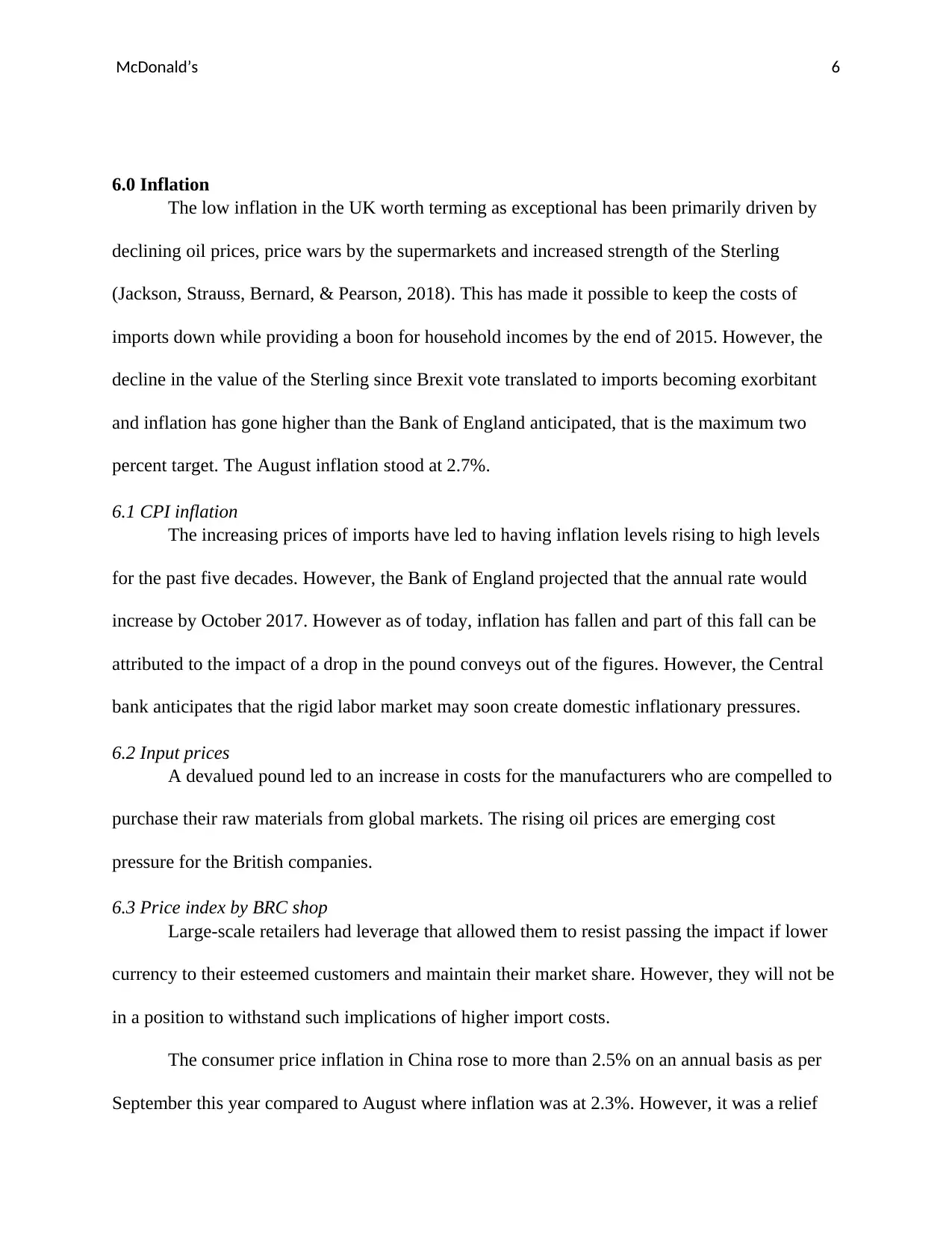
McDonald’s 6
6.0 Inflation
The low inflation in the UK worth terming as exceptional has been primarily driven by
declining oil prices, price wars by the supermarkets and increased strength of the Sterling
(Jackson, Strauss, Bernard, & Pearson, 2018). This has made it possible to keep the costs of
imports down while providing a boon for household incomes by the end of 2015. However, the
decline in the value of the Sterling since Brexit vote translated to imports becoming exorbitant
and inflation has gone higher than the Bank of England anticipated, that is the maximum two
percent target. The August inflation stood at 2.7%.
6.1 CPI inflation
The increasing prices of imports have led to having inflation levels rising to high levels
for the past five decades. However, the Bank of England projected that the annual rate would
increase by October 2017. However as of today, inflation has fallen and part of this fall can be
attributed to the impact of a drop in the pound conveys out of the figures. However, the Central
bank anticipates that the rigid labor market may soon create domestic inflationary pressures.
6.2 Input prices
A devalued pound led to an increase in costs for the manufacturers who are compelled to
purchase their raw materials from global markets. The rising oil prices are emerging cost
pressure for the British companies.
6.3 Price index by BRC shop
Large-scale retailers had leverage that allowed them to resist passing the impact if lower
currency to their esteemed customers and maintain their market share. However, they will not be
in a position to withstand such implications of higher import costs.
The consumer price inflation in China rose to more than 2.5% on an annual basis as per
September this year compared to August where inflation was at 2.3%. However, it was a relief
6.0 Inflation
The low inflation in the UK worth terming as exceptional has been primarily driven by
declining oil prices, price wars by the supermarkets and increased strength of the Sterling
(Jackson, Strauss, Bernard, & Pearson, 2018). This has made it possible to keep the costs of
imports down while providing a boon for household incomes by the end of 2015. However, the
decline in the value of the Sterling since Brexit vote translated to imports becoming exorbitant
and inflation has gone higher than the Bank of England anticipated, that is the maximum two
percent target. The August inflation stood at 2.7%.
6.1 CPI inflation
The increasing prices of imports have led to having inflation levels rising to high levels
for the past five decades. However, the Bank of England projected that the annual rate would
increase by October 2017. However as of today, inflation has fallen and part of this fall can be
attributed to the impact of a drop in the pound conveys out of the figures. However, the Central
bank anticipates that the rigid labor market may soon create domestic inflationary pressures.
6.2 Input prices
A devalued pound led to an increase in costs for the manufacturers who are compelled to
purchase their raw materials from global markets. The rising oil prices are emerging cost
pressure for the British companies.
6.3 Price index by BRC shop
Large-scale retailers had leverage that allowed them to resist passing the impact if lower
currency to their esteemed customers and maintain their market share. However, they will not be
in a position to withstand such implications of higher import costs.
The consumer price inflation in China rose to more than 2.5% on an annual basis as per
September this year compared to August where inflation was at 2.3%. However, it was a relief
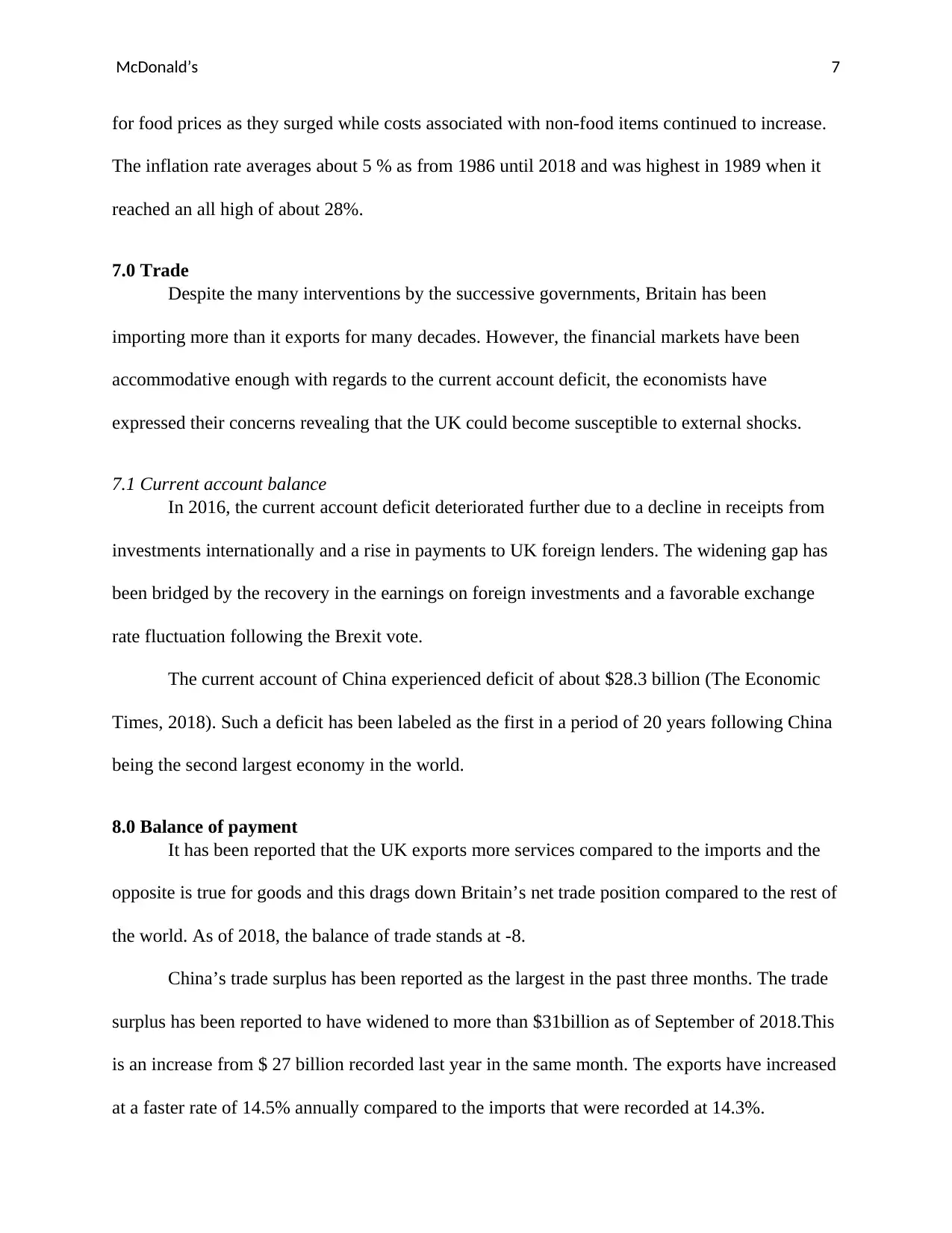
McDonald’s 7
for food prices as they surged while costs associated with non-food items continued to increase.
The inflation rate averages about 5 % as from 1986 until 2018 and was highest in 1989 when it
reached an all high of about 28%.
7.0 Trade
Despite the many interventions by the successive governments, Britain has been
importing more than it exports for many decades. However, the financial markets have been
accommodative enough with regards to the current account deficit, the economists have
expressed their concerns revealing that the UK could become susceptible to external shocks.
7.1 Current account balance
In 2016, the current account deficit deteriorated further due to a decline in receipts from
investments internationally and a rise in payments to UK foreign lenders. The widening gap has
been bridged by the recovery in the earnings on foreign investments and a favorable exchange
rate fluctuation following the Brexit vote.
The current account of China experienced deficit of about $28.3 billion (The Economic
Times, 2018). Such a deficit has been labeled as the first in a period of 20 years following China
being the second largest economy in the world.
8.0 Balance of payment
It has been reported that the UK exports more services compared to the imports and the
opposite is true for goods and this drags down Britain’s net trade position compared to the rest of
the world. As of 2018, the balance of trade stands at -8.
China’s trade surplus has been reported as the largest in the past three months. The trade
surplus has been reported to have widened to more than $31billion as of September of 2018.This
is an increase from $ 27 billion recorded last year in the same month. The exports have increased
at a faster rate of 14.5% annually compared to the imports that were recorded at 14.3%.
for food prices as they surged while costs associated with non-food items continued to increase.
The inflation rate averages about 5 % as from 1986 until 2018 and was highest in 1989 when it
reached an all high of about 28%.
7.0 Trade
Despite the many interventions by the successive governments, Britain has been
importing more than it exports for many decades. However, the financial markets have been
accommodative enough with regards to the current account deficit, the economists have
expressed their concerns revealing that the UK could become susceptible to external shocks.
7.1 Current account balance
In 2016, the current account deficit deteriorated further due to a decline in receipts from
investments internationally and a rise in payments to UK foreign lenders. The widening gap has
been bridged by the recovery in the earnings on foreign investments and a favorable exchange
rate fluctuation following the Brexit vote.
The current account of China experienced deficit of about $28.3 billion (The Economic
Times, 2018). Such a deficit has been labeled as the first in a period of 20 years following China
being the second largest economy in the world.
8.0 Balance of payment
It has been reported that the UK exports more services compared to the imports and the
opposite is true for goods and this drags down Britain’s net trade position compared to the rest of
the world. As of 2018, the balance of trade stands at -8.
China’s trade surplus has been reported as the largest in the past three months. The trade
surplus has been reported to have widened to more than $31billion as of September of 2018.This
is an increase from $ 27 billion recorded last year in the same month. The exports have increased
at a faster rate of 14.5% annually compared to the imports that were recorded at 14.3%.
Paraphrase This Document
Need a fresh take? Get an instant paraphrase of this document with our AI Paraphraser
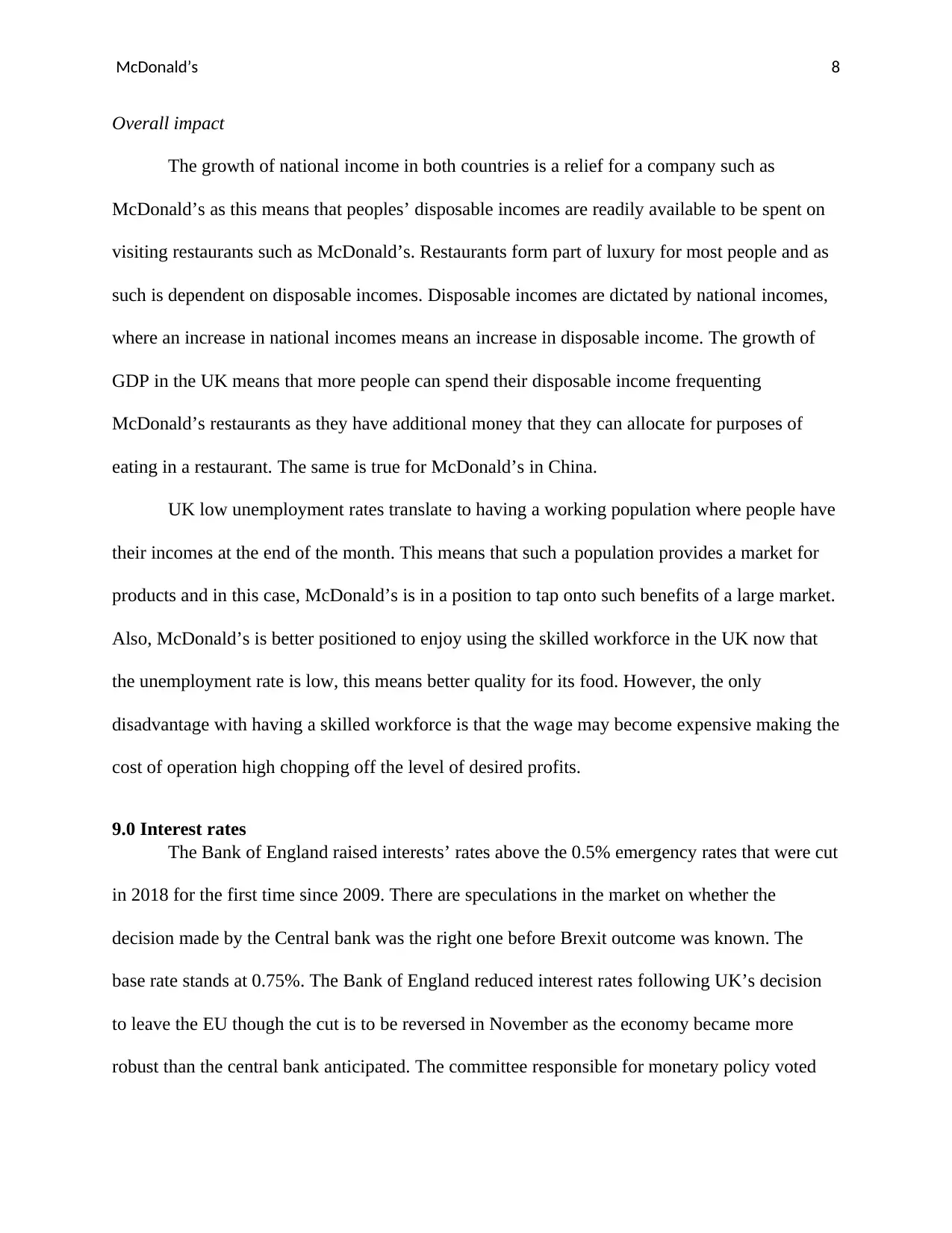
McDonald’s 8
Overall impact
The growth of national income in both countries is a relief for a company such as
McDonald’s as this means that peoples’ disposable incomes are readily available to be spent on
visiting restaurants such as McDonald’s. Restaurants form part of luxury for most people and as
such is dependent on disposable incomes. Disposable incomes are dictated by national incomes,
where an increase in national incomes means an increase in disposable income. The growth of
GDP in the UK means that more people can spend their disposable income frequenting
McDonald’s restaurants as they have additional money that they can allocate for purposes of
eating in a restaurant. The same is true for McDonald’s in China.
UK low unemployment rates translate to having a working population where people have
their incomes at the end of the month. This means that such a population provides a market for
products and in this case, McDonald’s is in a position to tap onto such benefits of a large market.
Also, McDonald’s is better positioned to enjoy using the skilled workforce in the UK now that
the unemployment rate is low, this means better quality for its food. However, the only
disadvantage with having a skilled workforce is that the wage may become expensive making the
cost of operation high chopping off the level of desired profits.
9.0 Interest rates
The Bank of England raised interests’ rates above the 0.5% emergency rates that were cut
in 2018 for the first time since 2009. There are speculations in the market on whether the
decision made by the Central bank was the right one before Brexit outcome was known. The
base rate stands at 0.75%. The Bank of England reduced interest rates following UK’s decision
to leave the EU though the cut is to be reversed in November as the economy became more
robust than the central bank anticipated. The committee responsible for monetary policy voted
Overall impact
The growth of national income in both countries is a relief for a company such as
McDonald’s as this means that peoples’ disposable incomes are readily available to be spent on
visiting restaurants such as McDonald’s. Restaurants form part of luxury for most people and as
such is dependent on disposable incomes. Disposable incomes are dictated by national incomes,
where an increase in national incomes means an increase in disposable income. The growth of
GDP in the UK means that more people can spend their disposable income frequenting
McDonald’s restaurants as they have additional money that they can allocate for purposes of
eating in a restaurant. The same is true for McDonald’s in China.
UK low unemployment rates translate to having a working population where people have
their incomes at the end of the month. This means that such a population provides a market for
products and in this case, McDonald’s is in a position to tap onto such benefits of a large market.
Also, McDonald’s is better positioned to enjoy using the skilled workforce in the UK now that
the unemployment rate is low, this means better quality for its food. However, the only
disadvantage with having a skilled workforce is that the wage may become expensive making the
cost of operation high chopping off the level of desired profits.
9.0 Interest rates
The Bank of England raised interests’ rates above the 0.5% emergency rates that were cut
in 2018 for the first time since 2009. There are speculations in the market on whether the
decision made by the Central bank was the right one before Brexit outcome was known. The
base rate stands at 0.75%. The Bank of England reduced interest rates following UK’s decision
to leave the EU though the cut is to be reversed in November as the economy became more
robust than the central bank anticipated. The committee responsible for monetary policy voted
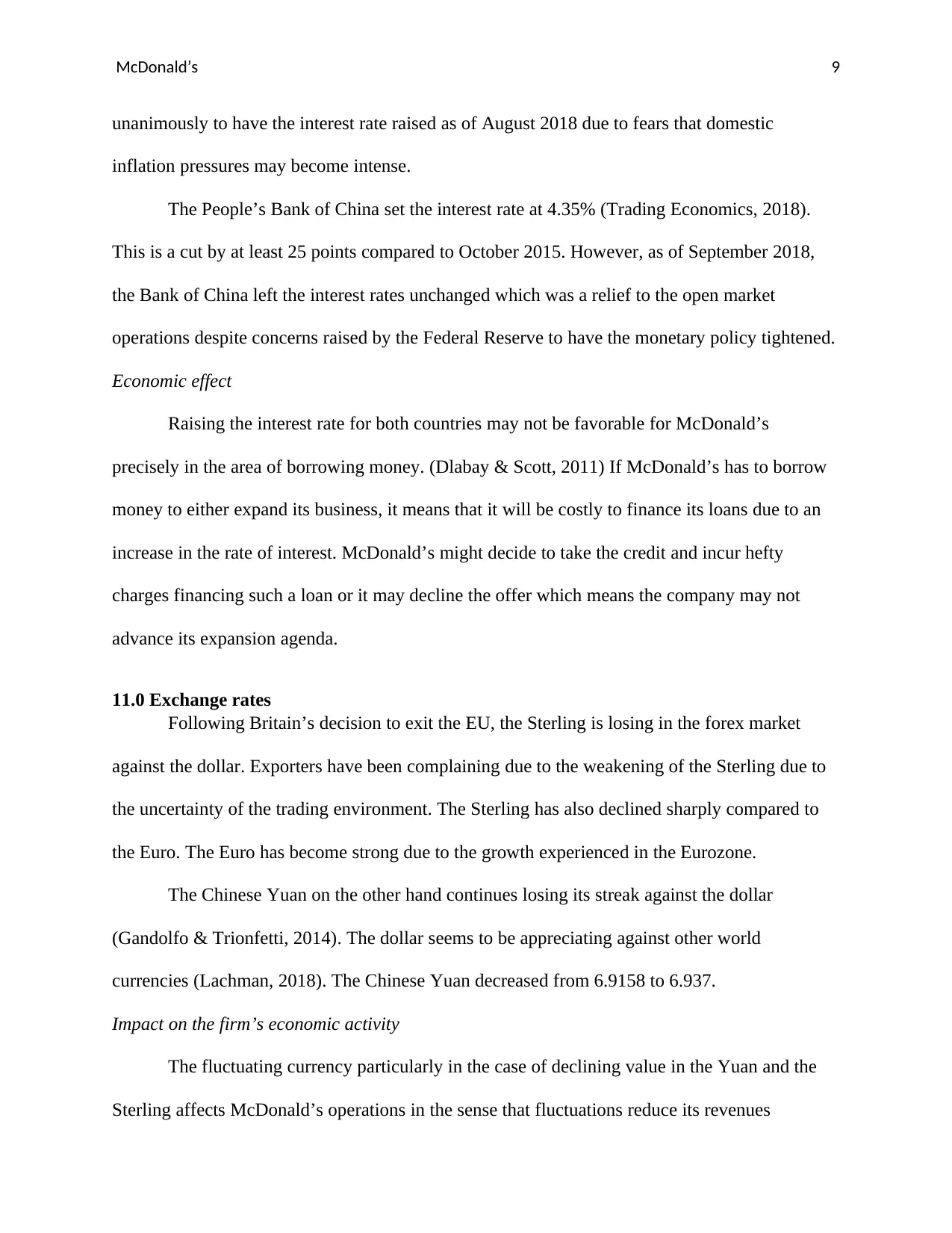
McDonald’s 9
unanimously to have the interest rate raised as of August 2018 due to fears that domestic
inflation pressures may become intense.
The People’s Bank of China set the interest rate at 4.35% (Trading Economics, 2018).
This is a cut by at least 25 points compared to October 2015. However, as of September 2018,
the Bank of China left the interest rates unchanged which was a relief to the open market
operations despite concerns raised by the Federal Reserve to have the monetary policy tightened.
Economic effect
Raising the interest rate for both countries may not be favorable for McDonald’s
precisely in the area of borrowing money. (Dlabay & Scott, 2011) If McDonald’s has to borrow
money to either expand its business, it means that it will be costly to finance its loans due to an
increase in the rate of interest. McDonald’s might decide to take the credit and incur hefty
charges financing such a loan or it may decline the offer which means the company may not
advance its expansion agenda.
11.0 Exchange rates
Following Britain’s decision to exit the EU, the Sterling is losing in the forex market
against the dollar. Exporters have been complaining due to the weakening of the Sterling due to
the uncertainty of the trading environment. The Sterling has also declined sharply compared to
the Euro. The Euro has become strong due to the growth experienced in the Eurozone.
The Chinese Yuan on the other hand continues losing its streak against the dollar
(Gandolfo & Trionfetti, 2014). The dollar seems to be appreciating against other world
currencies (Lachman, 2018). The Chinese Yuan decreased from 6.9158 to 6.937.
Impact on the firm’s economic activity
The fluctuating currency particularly in the case of declining value in the Yuan and the
Sterling affects McDonald’s operations in the sense that fluctuations reduce its revenues
unanimously to have the interest rate raised as of August 2018 due to fears that domestic
inflation pressures may become intense.
The People’s Bank of China set the interest rate at 4.35% (Trading Economics, 2018).
This is a cut by at least 25 points compared to October 2015. However, as of September 2018,
the Bank of China left the interest rates unchanged which was a relief to the open market
operations despite concerns raised by the Federal Reserve to have the monetary policy tightened.
Economic effect
Raising the interest rate for both countries may not be favorable for McDonald’s
precisely in the area of borrowing money. (Dlabay & Scott, 2011) If McDonald’s has to borrow
money to either expand its business, it means that it will be costly to finance its loans due to an
increase in the rate of interest. McDonald’s might decide to take the credit and incur hefty
charges financing such a loan or it may decline the offer which means the company may not
advance its expansion agenda.
11.0 Exchange rates
Following Britain’s decision to exit the EU, the Sterling is losing in the forex market
against the dollar. Exporters have been complaining due to the weakening of the Sterling due to
the uncertainty of the trading environment. The Sterling has also declined sharply compared to
the Euro. The Euro has become strong due to the growth experienced in the Eurozone.
The Chinese Yuan on the other hand continues losing its streak against the dollar
(Gandolfo & Trionfetti, 2014). The dollar seems to be appreciating against other world
currencies (Lachman, 2018). The Chinese Yuan decreased from 6.9158 to 6.937.
Impact on the firm’s economic activity
The fluctuating currency particularly in the case of declining value in the Yuan and the
Sterling affects McDonald’s operations in the sense that fluctuations reduce its revenues
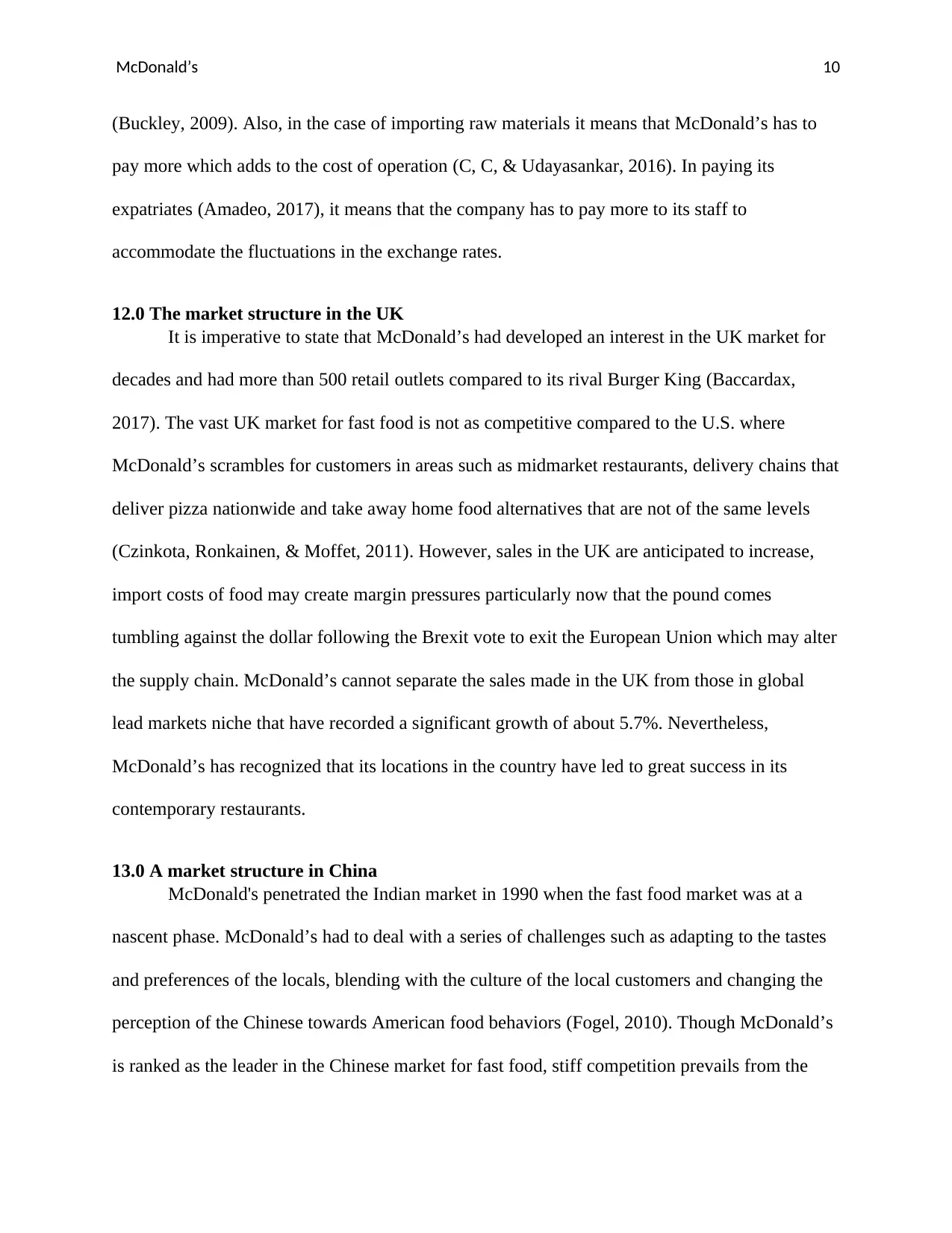
McDonald’s 10
(Buckley, 2009). Also, in the case of importing raw materials it means that McDonald’s has to
pay more which adds to the cost of operation (C, C, & Udayasankar, 2016). In paying its
expatriates (Amadeo, 2017), it means that the company has to pay more to its staff to
accommodate the fluctuations in the exchange rates.
12.0 The market structure in the UK
It is imperative to state that McDonald’s had developed an interest in the UK market for
decades and had more than 500 retail outlets compared to its rival Burger King (Baccardax,
2017). The vast UK market for fast food is not as competitive compared to the U.S. where
McDonald’s scrambles for customers in areas such as midmarket restaurants, delivery chains that
deliver pizza nationwide and take away home food alternatives that are not of the same levels
(Czinkota, Ronkainen, & Moffet, 2011). However, sales in the UK are anticipated to increase,
import costs of food may create margin pressures particularly now that the pound comes
tumbling against the dollar following the Brexit vote to exit the European Union which may alter
the supply chain. McDonald’s cannot separate the sales made in the UK from those in global
lead markets niche that have recorded a significant growth of about 5.7%. Nevertheless,
McDonald’s has recognized that its locations in the country have led to great success in its
contemporary restaurants.
13.0 A market structure in China
McDonald's penetrated the Indian market in 1990 when the fast food market was at a
nascent phase. McDonald’s had to deal with a series of challenges such as adapting to the tastes
and preferences of the locals, blending with the culture of the local customers and changing the
perception of the Chinese towards American food behaviors (Fogel, 2010). Though McDonald’s
is ranked as the leader in the Chinese market for fast food, stiff competition prevails from the
(Buckley, 2009). Also, in the case of importing raw materials it means that McDonald’s has to
pay more which adds to the cost of operation (C, C, & Udayasankar, 2016). In paying its
expatriates (Amadeo, 2017), it means that the company has to pay more to its staff to
accommodate the fluctuations in the exchange rates.
12.0 The market structure in the UK
It is imperative to state that McDonald’s had developed an interest in the UK market for
decades and had more than 500 retail outlets compared to its rival Burger King (Baccardax,
2017). The vast UK market for fast food is not as competitive compared to the U.S. where
McDonald’s scrambles for customers in areas such as midmarket restaurants, delivery chains that
deliver pizza nationwide and take away home food alternatives that are not of the same levels
(Czinkota, Ronkainen, & Moffet, 2011). However, sales in the UK are anticipated to increase,
import costs of food may create margin pressures particularly now that the pound comes
tumbling against the dollar following the Brexit vote to exit the European Union which may alter
the supply chain. McDonald’s cannot separate the sales made in the UK from those in global
lead markets niche that have recorded a significant growth of about 5.7%. Nevertheless,
McDonald’s has recognized that its locations in the country have led to great success in its
contemporary restaurants.
13.0 A market structure in China
McDonald's penetrated the Indian market in 1990 when the fast food market was at a
nascent phase. McDonald’s had to deal with a series of challenges such as adapting to the tastes
and preferences of the locals, blending with the culture of the local customers and changing the
perception of the Chinese towards American food behaviors (Fogel, 2010). Though McDonald’s
is ranked as the leader in the Chinese market for fast food, stiff competition prevails from the
Secure Best Marks with AI Grader
Need help grading? Try our AI Grader for instant feedback on your assignments.
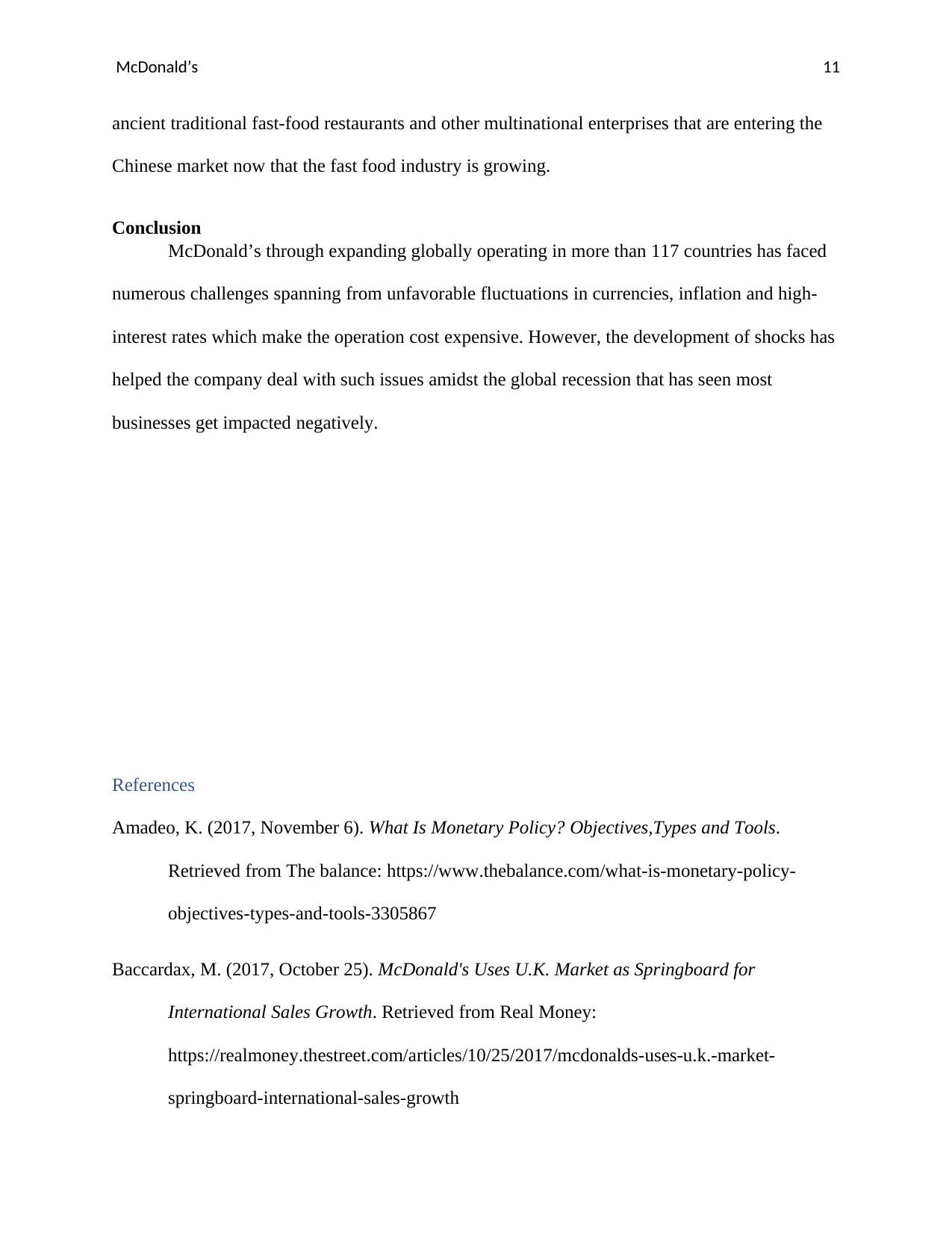
McDonald’s 11
ancient traditional fast-food restaurants and other multinational enterprises that are entering the
Chinese market now that the fast food industry is growing.
Conclusion
McDonald’s through expanding globally operating in more than 117 countries has faced
numerous challenges spanning from unfavorable fluctuations in currencies, inflation and high-
interest rates which make the operation cost expensive. However, the development of shocks has
helped the company deal with such issues amidst the global recession that has seen most
businesses get impacted negatively.
References
Amadeo, K. (2017, November 6). What Is Monetary Policy? Objectives,Types and Tools.
Retrieved from The balance: https://www.thebalance.com/what-is-monetary-policy-
objectives-types-and-tools-3305867
Baccardax, M. (2017, October 25). McDonald's Uses U.K. Market as Springboard for
International Sales Growth. Retrieved from Real Money:
https://realmoney.thestreet.com/articles/10/25/2017/mcdonalds-uses-u.k.-market-
springboard-international-sales-growth
ancient traditional fast-food restaurants and other multinational enterprises that are entering the
Chinese market now that the fast food industry is growing.
Conclusion
McDonald’s through expanding globally operating in more than 117 countries has faced
numerous challenges spanning from unfavorable fluctuations in currencies, inflation and high-
interest rates which make the operation cost expensive. However, the development of shocks has
helped the company deal with such issues amidst the global recession that has seen most
businesses get impacted negatively.
References
Amadeo, K. (2017, November 6). What Is Monetary Policy? Objectives,Types and Tools.
Retrieved from The balance: https://www.thebalance.com/what-is-monetary-policy-
objectives-types-and-tools-3305867
Baccardax, M. (2017, October 25). McDonald's Uses U.K. Market as Springboard for
International Sales Growth. Retrieved from Real Money:
https://realmoney.thestreet.com/articles/10/25/2017/mcdonalds-uses-u.k.-market-
springboard-international-sales-growth
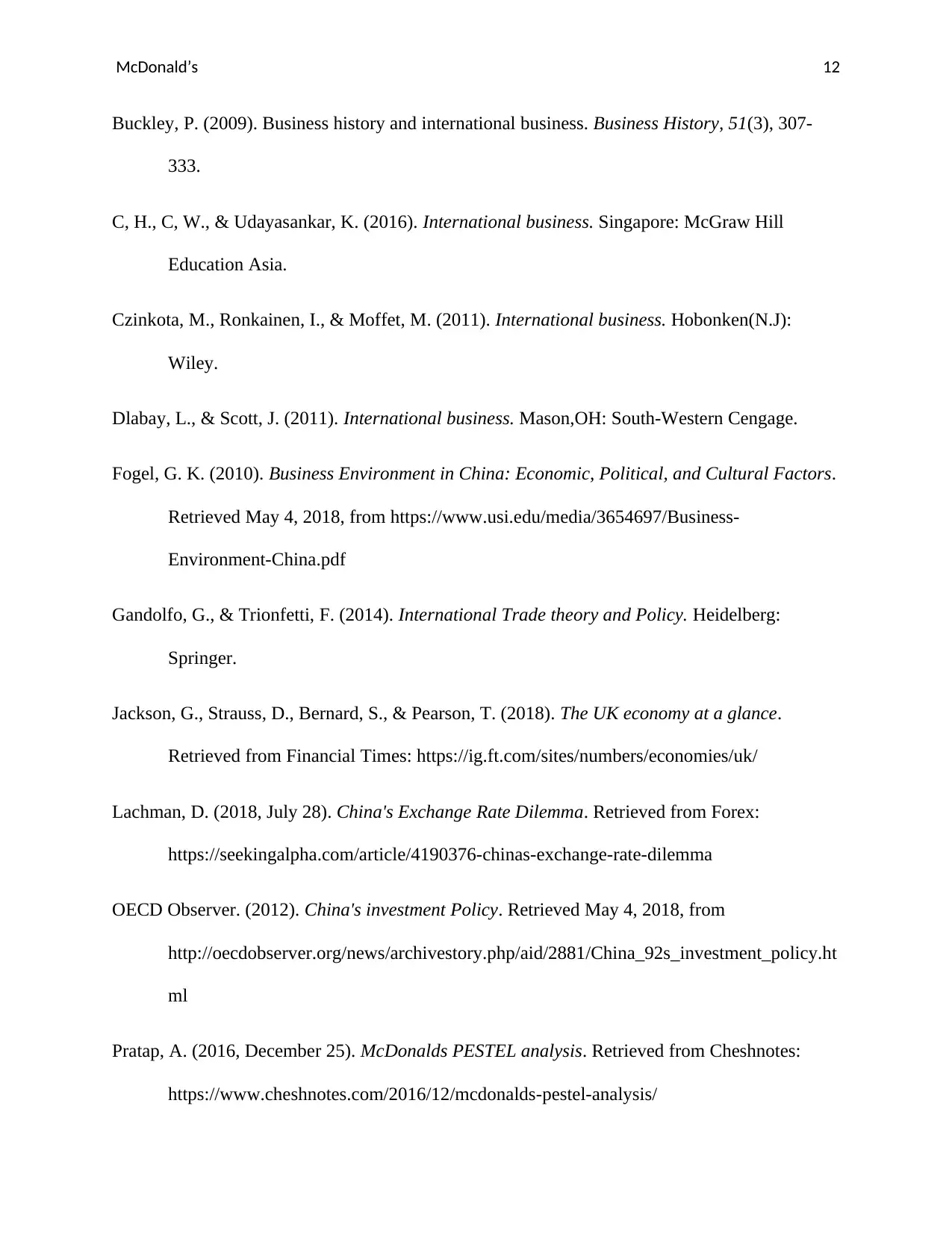
McDonald’s 12
Buckley, P. (2009). Business history and international business. Business History, 51(3), 307-
333.
C, H., C, W., & Udayasankar, K. (2016). International business. Singapore: McGraw Hill
Education Asia.
Czinkota, M., Ronkainen, I., & Moffet, M. (2011). International business. Hobonken(N.J):
Wiley.
Dlabay, L., & Scott, J. (2011). International business. Mason,OH: South-Western Cengage.
Fogel, G. K. (2010). Business Environment in China: Economic, Political, and Cultural Factors.
Retrieved May 4, 2018, from https://www.usi.edu/media/3654697/Business-
Environment-China.pdf
Gandolfo, G., & Trionfetti, F. (2014). International Trade theory and Policy. Heidelberg:
Springer.
Jackson, G., Strauss, D., Bernard, S., & Pearson, T. (2018). The UK economy at a glance.
Retrieved from Financial Times: https://ig.ft.com/sites/numbers/economies/uk/
Lachman, D. (2018, July 28). China's Exchange Rate Dilemma. Retrieved from Forex:
https://seekingalpha.com/article/4190376-chinas-exchange-rate-dilemma
OECD Observer. (2012). China's investment Policy. Retrieved May 4, 2018, from
http://oecdobserver.org/news/archivestory.php/aid/2881/China_92s_investment_policy.ht
ml
Pratap, A. (2016, December 25). McDonalds PESTEL analysis. Retrieved from Cheshnotes:
https://www.cheshnotes.com/2016/12/mcdonalds-pestel-analysis/
Buckley, P. (2009). Business history and international business. Business History, 51(3), 307-
333.
C, H., C, W., & Udayasankar, K. (2016). International business. Singapore: McGraw Hill
Education Asia.
Czinkota, M., Ronkainen, I., & Moffet, M. (2011). International business. Hobonken(N.J):
Wiley.
Dlabay, L., & Scott, J. (2011). International business. Mason,OH: South-Western Cengage.
Fogel, G. K. (2010). Business Environment in China: Economic, Political, and Cultural Factors.
Retrieved May 4, 2018, from https://www.usi.edu/media/3654697/Business-
Environment-China.pdf
Gandolfo, G., & Trionfetti, F. (2014). International Trade theory and Policy. Heidelberg:
Springer.
Jackson, G., Strauss, D., Bernard, S., & Pearson, T. (2018). The UK economy at a glance.
Retrieved from Financial Times: https://ig.ft.com/sites/numbers/economies/uk/
Lachman, D. (2018, July 28). China's Exchange Rate Dilemma. Retrieved from Forex:
https://seekingalpha.com/article/4190376-chinas-exchange-rate-dilemma
OECD Observer. (2012). China's investment Policy. Retrieved May 4, 2018, from
http://oecdobserver.org/news/archivestory.php/aid/2881/China_92s_investment_policy.ht
ml
Pratap, A. (2016, December 25). McDonalds PESTEL analysis. Retrieved from Cheshnotes:
https://www.cheshnotes.com/2016/12/mcdonalds-pestel-analysis/
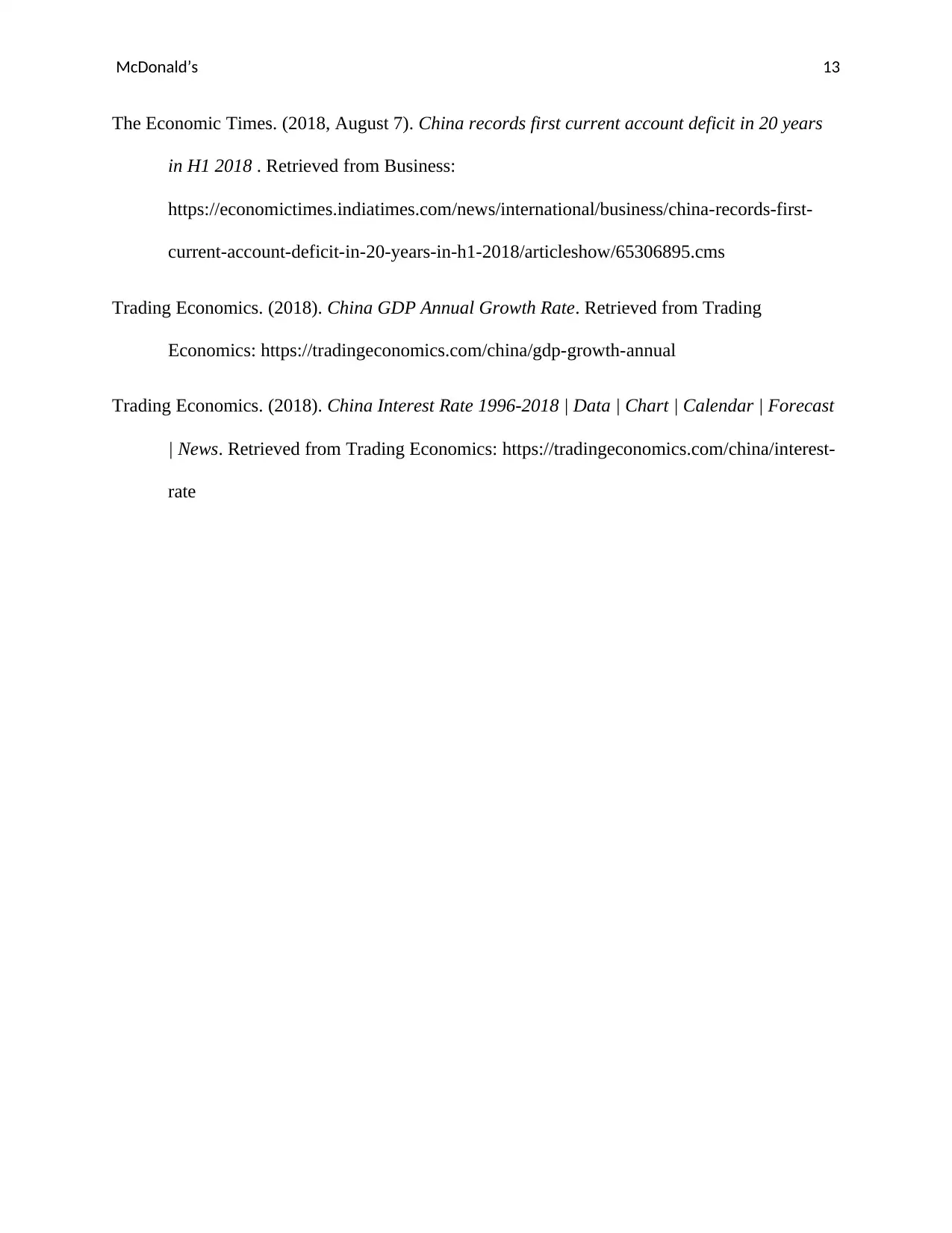
McDonald’s 13
The Economic Times. (2018, August 7). China records first current account deficit in 20 years
in H1 2018 . Retrieved from Business:
https://economictimes.indiatimes.com/news/international/business/china-records-first-
current-account-deficit-in-20-years-in-h1-2018/articleshow/65306895.cms
Trading Economics. (2018). China GDP Annual Growth Rate. Retrieved from Trading
Economics: https://tradingeconomics.com/china/gdp-growth-annual
Trading Economics. (2018). China Interest Rate 1996-2018 | Data | Chart | Calendar | Forecast
| News. Retrieved from Trading Economics: https://tradingeconomics.com/china/interest-
rate
The Economic Times. (2018, August 7). China records first current account deficit in 20 years
in H1 2018 . Retrieved from Business:
https://economictimes.indiatimes.com/news/international/business/china-records-first-
current-account-deficit-in-20-years-in-h1-2018/articleshow/65306895.cms
Trading Economics. (2018). China GDP Annual Growth Rate. Retrieved from Trading
Economics: https://tradingeconomics.com/china/gdp-growth-annual
Trading Economics. (2018). China Interest Rate 1996-2018 | Data | Chart | Calendar | Forecast
| News. Retrieved from Trading Economics: https://tradingeconomics.com/china/interest-
rate
1 out of 13
Related Documents
Your All-in-One AI-Powered Toolkit for Academic Success.
+13062052269
info@desklib.com
Available 24*7 on WhatsApp / Email
![[object Object]](/_next/static/media/star-bottom.7253800d.svg)
Unlock your academic potential
© 2024 | Zucol Services PVT LTD | All rights reserved.





